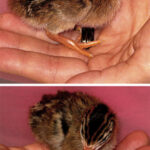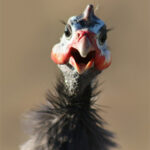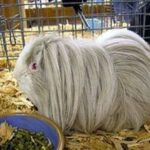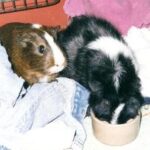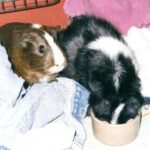The rock hyrax, procavia capensis, may look like a guinea pig, but is actually more closely related to both elephants and manatees. They stand about 8 to 12 inches (30.5 centimeters) tall at the shoulders and measure 11.8 to 22.8 inches (30 to 58 centimeters) long. They weigh anywhere from 4 to 12 pounds (1.8 to 5.4 kilograms) and have no tail. A rock hyrax has short, brown fur with a lighter underbelly as well as a distinctive patch on the back which may be black, yellow or orange. This patch covers a gland that can produce a characteristic odor. In addition to its short fur, it has extra long hairs that stick out around the body (called guard hairs) which help it to feel its way around.
The rock hyrax can be found in both Africa as well as the coast of the Arabian Peninsula. As the name implies, they will inhabit areas where there are boulders, rock formations, or little nooks on sheer cliffs to provide both shelter and protection for them. They are able to easily navigate their way around their rocky environment due to the soles of their feet, which are moist and rubber-like, which provide a good grip. These animals live in a group (called a colony) that may contain as many as 50 individuals (although 26 is the average) and consists of a breeding male, several females and their young as well as a subordinate male sometimes. They communicate with one another through various whistles, growls, twitters and shrieks. They look for food during the day, foraging together in groups.
The diet of a rock hyrax consists of grasses, forbs, shrubs, leaves, fruits, lizards, insects and bird eggs. They will eat in a circle formation with their heads pointing outward in order to keep an eye out for predators. They are able to see predators up to 1,000 yards (900 meters) away. The dominant male will look out for danger after every bite, making a shrieking sound if predators like a leopard, serval, python or bird of prey is detected. The group will then run for cover and remain perfectly still until they feel the threat has passed.
Breeding season for the rock hyrax is at different times depending on the location. Females will give birth to 1 to 6 offspring after a gestation period of 7 to 8 months. The entire group will greet and sniff the young ones when they are born. A nursery group is formed to help care for the babies. The little ones will begin trying to eat solid food at just 3 days of age (although they will continue to nurse). They will eat hyrax dung in order to obtain the bacteria they need to digest plants. Females will remain in the colony for life while males leave at around 2 years old to live on the outskirts of another colony (maybe taking it over once it gets older). If the little ones can survive long enough, then they can live to be 9 to 14 years old.
The rock hyrax is not an endangered species and has in fact become as common as the North American squirrel. This has led to them being seen as pests in addition to being hunted for their meat and soft fur. Hopefully, the rock hyrax can continue its peaceful coexistence with humans. After all, such a unique creature deserves to live and prosper far into the future.
Works Cited
“Rock Hyrax” 18 June 2011
“Mammals: Rock Hyrax” 28 June 2011
“Rock Hyrax (Procavia Capensis)” 28 June 2011
